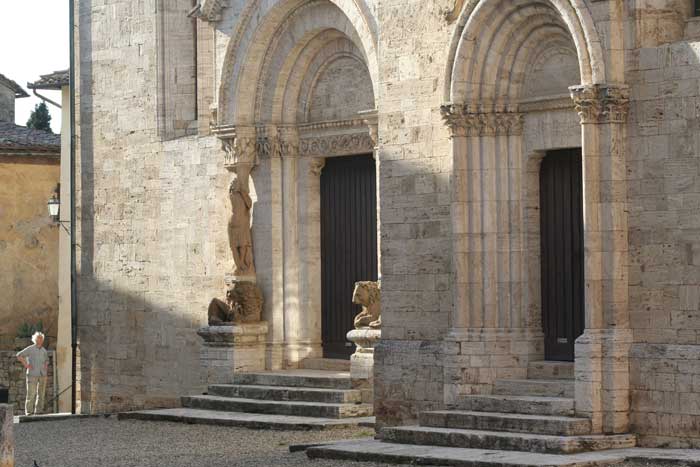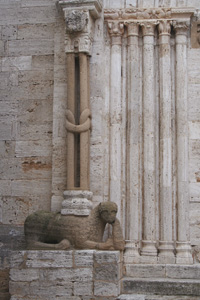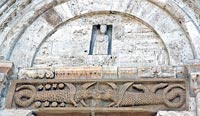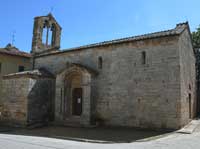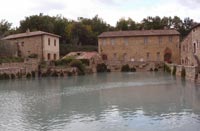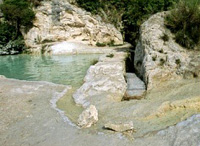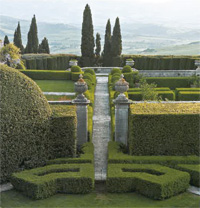San Quirico d'Orcia |
San Quirico d'Orcia is an enchanting little medieval town on the Via Francigena. An imposing perimeter wall protects San Quirico d'Orcia,, accessed by a gateway, the only of the four original gateways to have survived the passage of time. The historic center of San Quirico perfectly conserves its medieval plan and a great number of impressive works of architecture such as the Romanesque Church of the Collegiata, with its three portals one of which attributed to Giovanni Pisano; the 17th century Palazzo Chigi; the Church of San Francesco which houses a Madonna by Andrea della Robbia; the Horti Leonini, splendid example of late 16th century landscape gardening; the intimate Romanesque Church of Santa Maria dell'Assunta and the Ospedale della Scala, once the refuge of pilgrims travelling along the via Francigena. |
San Quirico d'Orcia, alley with the Collegiate [2]
|
| To reach San Quirico we can follow the old stretch of the Cassia through the center of Torrenieri, or a longer, recently built road which can be traveled more easily. They both offer beautiful views over the rolling hills of the Asso and Orcia valleys, with some of the most photographed countryside in Tuscany. Seat of a parish church which dates back to the dynasty of the Lombards, the San Quirico Castle took on remarkable importance during the course of the 12th century when the heads of the Empire made it their residence. Between the end of the century and the beginning of the 13th century it was taken under the jurisdiction of Siena, and from 1262 it was center of a vicariate. In 1213 its men swore to the Sienese podesta that they would guard a stretch of the Francigena. Because of its position as the last large castle before one of the most insecure stretches of the entire route, San Quirico, center of numerous hospices, was an important stopping place along the road and was mentioned in both Sigeric's I about 990, and in Philip's (t 191) itineraries. Its urban structure, built within the nucleus of the Castle (or Hillock) which is the most ancient part, and the Hamlet, later included within the boundary walls, developed mostly along the Francigena, from Porta Camaldoli to Porta Ferrea, (which no longer exist). Major architectural evidence can be found along this route, most importantly the parish church which is now a collegiate church, documented since the year 714. The present-day building with features ranging from Romanesque to Gothic, has a Latin cross plan with two polygonal apses in ~e transept wings and a large 17t century, quadrangular choir. The ceiling of the nave with wooden roof-trusses shows traces of the original polycromy brought to light during restorations carried out in the 19 century. To be noted, among other works of art, are a 15t century panel attributed to Sano di Pietro (Madonna and Child with Angels and Saints). Antonio Barili's (1482-1502) inlaid wood choir stalls, and the tombstone of Count Enrico di Nassau, who died in San Quirico on his return from Rome during the Holy Year pilgrimage in 1450.
|
||
 |
||
| San Quirico d'Orcia, The Collegiate, detail [2] | ||
| Now we leave the Cassia and take the dirt road from San Quirico that leads to Bagno Vignoni. The route, all along a ridge offers some of the most breathtaking vistas of the Sienese countryside, with wide-sweeping views over the Val d'Orcia, Mount Amiata, and the Val dAsso. In 1051 the Vignoni Castle was confirmed by Henry III to the Abbey of Sant' Antimo. From the mid-12th century it was ruled by the lords of the Tentennano fortress and in 1208, it was already one of the castles that was obliged to pay a tax to the Commune of Siena. The present-day settlement is formed by a few farmhouses, a large building dating back 10 the late Middle Ages, a partially demolished tower with very high scarp base and, at the end of the village beside a gate in the boundary walls, a lovely Romanesque church dedicated to Saint Blaise. The building, with small nave and roof-trusses, has a round arched portal in the façade with single lancet window and two small cruciform windows above, and in the far wall, without apse, a bell gable with human head sculpted into the base. On the inside there are remains of 14th and 15t century frescoes. From Vignoni we continue until the Ripa Castle and then return to San Quirico where we pick up the Cassia once more. The road goes down rapidly amidst scenery of great beauty, until it reaches the bridge over the Orcia. This one is new, but a short distance away in the confluence of the Rimugini brook the remains of a medieval bridge, with travertine voussoir piers, are preserved. Nearby there is a hospital that was donated to Santa Maria della Scala in 1236. Immediately preceding the present day bridge a right turn leads to Bagno Vignoni, famous thermal spa known since Roman times. In the Middle Ages it was a village with several hospices and a parish church. At the beginning of the 14th century it passed under the jurisdiction of the Salimbeni family and at the end of the century it was taken under the control of Siena. Bordered by a 14th century wall, the pool is continually replenished with warm water (52°) from the village's thermal springs. The health inducing properties of the water have been known since ancient times. Today, the waters are used in spa therapies performed in the various wellness centers situated in Bagno Vignoni. Surrounding it are buildings from different periods, among them a small structure with 1St century characteristics, the Church of San Giovanni. restored in the 18t century, and an arcade with a 17th century chapel dedicated to Saint Catherine, who frequently stayed here. The water trickles from the pool through the rocks out of the hamlet, and after passing a series of artificial tubs gushes along the hill forming little waterfalls and natural pools, thereby creating a highly suggestive ambiance.A typical loggia supported by pillars in travertine marble closes the fourth side of the baths. Legend has it that Saint Catherine, after whom the loggia takes its name, used to bathe in these waters, as did members of all the great noble families of Siena. On cold winter nights, the contrast between the external temperature and that of the warm thermal waters produces vapours which rise up from the pool and envelop the whole of Bagno Vignoni. The resulting magical, almost surreal atmosphere, was immortalised in the Russian director Andrej Tarkóvskij's film Nostalgia. |
|
|
Horti Leonini in San Quirico d'Orcia |
||
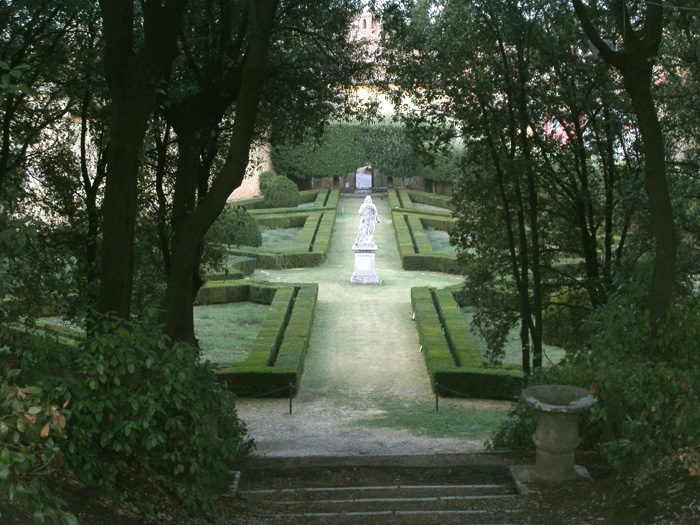 |
||
Horti Leonini in San Quirico d'Orcia |
||
|
||
Villa La Foce |
||
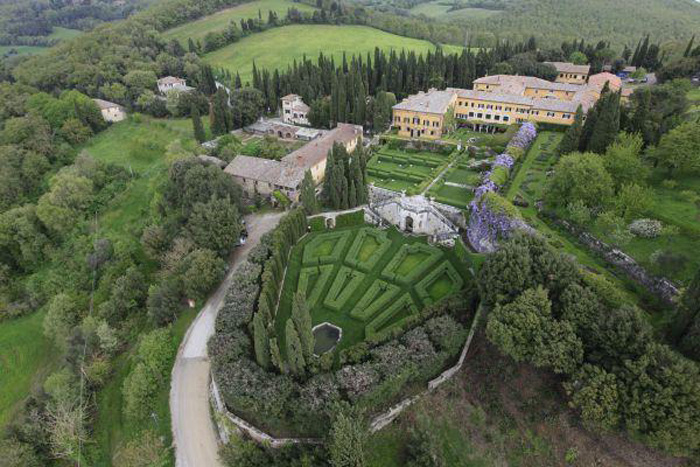 |
||
Villa La Foce |
||
| In 1924 the Irish-American Iris Origo - the famous author - and her Italian husband, Marchese Antonio Origo, acquired the La Foce estate- a combination of olive groves, widespread cultivated fields and woodland. In those days, their management of La Foce brought prosperity and cultural and social changes to the poverty-ridden land it was then. Today their daughters, Benedetta and Donata, run the La Foce estate and their personality pervades in the hospitable atmosphere. The garden at La Foce was designed by Iris Origo and the famous English landscape gardener Cecil Pinsent between 1925 and 1939. Iris already knew Cecil as he had worked on her mother's house, Villa Medici, in Fiesole, and the nearby house of friend Bernard Berenson, Villa I Tatti. On these two properties Cecil had proved not only that he could design and redesign a home, but also that he was also talented in creating landscapes. La Foce has also become a centre for cultural and artistic activities. Castelluccio (literally little castle), a mediaeval castle on the property, is the home of an international music festival, Incontri in Terra di Siena. It also hosts art exhibitions, as well as courses on garden history and landscaping. Each summer, the cultural association La Tartaruga organizes art shows at the medieval castle Castelluccio. The curator, Plinio de Martiis (known for his important gallery in Rome) has in recent years brought the work of renowned artists such as Kounellis and Manzoni to Castelluccio, as well as promoting young, less famous artists. Gardens in Tuscany | Villa La Foce Incontri in Terra di Siena | www.itslafoce.org |
||
|
||||
Wikimedia Commons contiene immagini o altri file su San Quirico d'Orcia
|
||||
|
||||
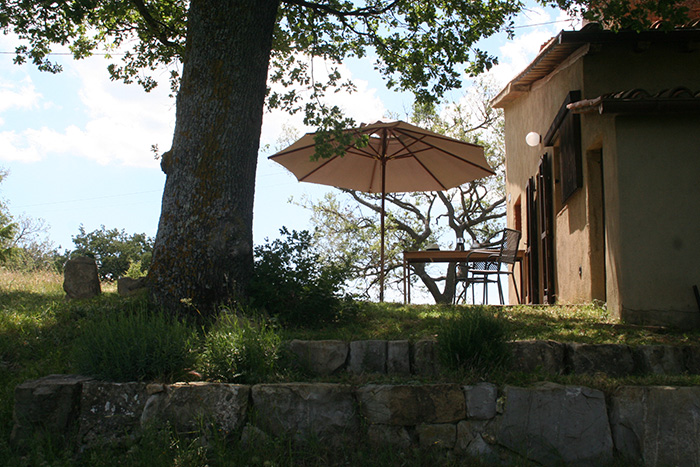 |
||||
View on the northern terrace
|
||||
